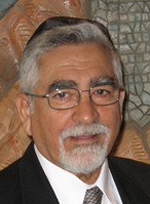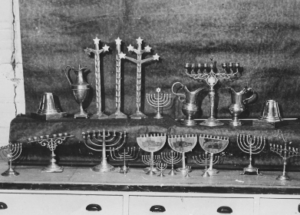By Dorian de Wind

AUSTIN, Texas — Since the Jewish calendar is based on lunar months, the eight days of the Jewish festival Hanukkah do not begin on the same (Gregorian calendar) date every year.
During the Holocaust, at Hitler’s death camps, the first night of Hanukkah fell on dates ranging from December 3 to December 24.
As Jews around the world light the first candle of the menorah at sunset Sunday, one must wonder how Hanukkah was celebrated “in the realm of darkness, somewhere on the ground in Poland’s defiled Auschwitz,” as Ellie Wiesel writes.
December 1942 saw some of the bloodiest, ugliest fighting of World War II: “Men were killing each other in greater numbers than ever before. The Holocaust continued, and innocent civilians were murdered by the thousands throughout the evil Nazi empire…” While the words in this book review refer mainly to “The Darkest Christmas: December 1942…”, the atrocities committed against Jews during Hanukkah were even more cruel, even more godless.
Hanukkah, like other Jewish holidays, was deliberately chosen by the Nazis as an occasion for humiliating, torturing and slaughtering Jews.

In no other Nazi death camp was this done more callously, more “efficiently” than at the largest, most notorious and deadliest camp, the Auschwitz-Birkenau complex. A camp where it is estimated that – as part of Hitler’s “Final Solution” — around 1.1 million human beings were murdered, one million of them Jews.
Auschwitz Memorial and other groups and organizations meticulously maintain and publish information and data of events at the Auschwitz death camp.
From those accounts, one can paint a reliable picture of what transpired at that camp during the eight days of Hanukkah in 1942.
On December 3, even before the first menorah candle was lit (at places where Hanukkah could be celebrated), the SS (Schutzstaffel; protective echelon) escorted around 400 Jewish prisoners of the Sonderkommando from Birkenau to Auschwitz I. They had been forced to dig up and burn circa 107,000 corpses. They were led into the gas chamber by crematorium I and killed.
There would be no shortage of human beings to exterminate, to torture or to work to death as for the next several days the transports would keep bringing Jews from the transit camp Westerbork in the Netherlands, from the ghetto in Mlawa, Poland, and from a transit camp in Malkinia Poland — altogether 6738 men, women and children. Of these, 5763 prisoners were murdered in the Auschwitz-Birkenau gas chambers.
On the final day of Hanukkah, the SS chose several dozen healthy men out of the 524 men from Malkinia who had been spared the previous day and sent them to the Sonderkommando, where they were forced to empty the gas chambers. Among the remains were relatives and friends from the same transport they arrived in the day before.
The acts of torture, murder and desecration continued during Hanukkah of 1943 and 1944.
Holocaust survivor Bart Stern describes one Hanukkah he spent at Auschwitz as follows:
So, the Germans made a Hanukkah celebration: on the poles of the barracks, the outside poles, they hung up the prisoners who were chosen to be one of the ten, of the tens, on their feet, head down. We had to pour oil on them, and they had a bonfire, and we had to sing Christmas songs. “Heilige Nacht” [“Silent Night”], I mean, we, they, we had to sing the songs while our brothers, our fathers, our, our cousins were burning.
In a December 2007 New York Times column, Jeff Jacoby, whose father spent the 1944 Hanukah at Auschwitz, quotes historian Yaffa Eliach from her book “Hasidic Tales of the Holocaust” about one such Nazi Hanukkah atrocity:
The men selected were marched outside. SS men with rubber truncheons and iron prods awaited them. They kicked, beat, and tortured the innocent victims. When the tortured body no longer responded, the revolver was used….The brutal massacre continued outside of the barracks until sundown. When the [Nazis] departed, they left behind heaps of hundreds of tortured and twisted bodies.
But even in a place where almost any infraction, including one related to the Jewish faith, was punishable by death, the Nazis were not able to totally kill the Hanukkah spirit, the Jewish faith.
The Holocaust literature is full of examples where Jewish prisoners summed up the courage, hope, tenacity and imagination to find ways to kindle a flame, to celebrate Hanukkah amid the horrors of their captivity.
They would find or steal oil; fashion makeshift wicks from scraps of fat or from threads from their thin blankets; use carved potatoes to kindle the Hanukkah lights; carve whole menorahs out of stolen blocks of wood or just turn a simple, smuggled spoon into a menorah. “Even dreidels for the children in the camp were carved out of the wooden shoes that inmates wore.”
Recalling how a fellow Auschwitz prisoner, while “December winds were carousing, storming over the camp that looked like a burial ground marked with snow-covered tombstones,” organized a Hanukkah celebration, Ellie Wiesel writes, “But I did not forget his act of courage. Year in, year out, when the world is celebrating Hanukkah, I remember him.”
At a time of increasing antisemitism, so must we.
*
Dorian de Wind is a retired U.S. Air Force officer and a writer. This article appeared initially on The Moderate Voice website, with which San Diego Jewish World trades stories under auspices of the San Diego Online News Association.